Australian Magpie
Conservation status Least concern |
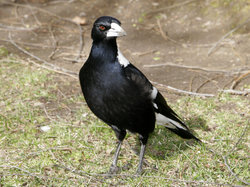
|
|
Scientific classification |
| Kingdom: |
Animalia
|
| Phylum: |
Chordata
|
| Class: |
Aves
|
| Order: |
Passeriformes
|
| Family: |
Artamidae
|
| Genus: |
Gymnorhina
Gray,GR, 1840 |
| Species: |
G. tibicen
|
|
|
Binomial name |
Gymnorhina tibicen
(Latham,
1802) |
The Australian Magpie (Gymnorhina tibicen)
is a medium-sized black and white bird, closely related to
the
butcherbirds and
currawongs. Early European settlers named it for its
black and white coloration, similar to the familiar
European magpie, which is a more distant relative.
Description
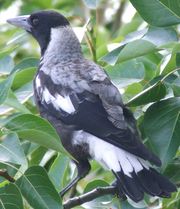
Immature white-backed female, with dark eyes, in
Dromana, Victoria
Adult magpies are fairly solid, well-built birds with
pure black and white plumage: juveniles mix the stark blacks
and whites with lighter greys and browns. Males and females
are generally similar in appearance, though a few exceptions
noted under individual varieties below.
Mature magpies have red eyes, in contrast to the yellow
eyes of currawongs and white eyes of Australian ravens and
crows. Immature birds have darker brownish eyes.
Butcherbirds are generally smaller and stockier, while
magpie larks are delicate birds with white eyes.
Some magpies have lived up to 30 years.
Subspecies
There are currently thought to be eight subspecies of
Australian magpie. The black-backed magpie,
originally known as Gymnorhina tibicen tibicen, has
been split into at least three black-backed races:
- G. tibicen tibicen, found in eastern
New South Wales
- G. tibicen terraereginae found across
Queensland, central and western New South Wales and into
northern South Australia
- G. tibicen eylandtensis, found across the
Northern Territory
- G. tibicen longirostris, found across
northern
Western Australia
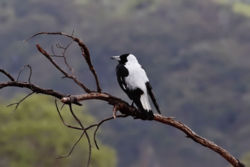
Magpie perched on a dead branch
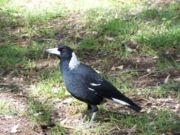
Western Magpie female
The White-backed Magpie, originally G. tibicen
hypoleuca, has similarly been split into races:
- G. tibicen tyrannica, a very large white
backed form found across southern
Victoria
- G. tibicen telonocua, found in southern
South Australia
- The Tasmanian Magpie (G. tibicen hypoleuca),
a small white-backed subspecies with a short compact
bill found on King and Flinders Islands, as well as
Tasmania.
- The Western Magpie (G. tibicen dorsalis)
in the fertile south-west corner of Western Australia.
These three races, tibicen, hypoleuca and
dorsalis, were for many years considered separate
species; however, they were noted to hybridise readily where
their territories cross, with hybrid grey or striped-backed
magpies being quite common.
Behaviour
Australian magpies have a musical warbling call. Noted
New Zealand poet Denis Glover wrote "quardle oodle ardle wardle doodle,
the magpies say". In contrast, young magpies squawk almost
continuously.
Magpies mate throughout the year, but generally in
winter. Nesting takes place in winter, and chicks hatch in
early spring. By late summer the babies either form their
own flock or separate from their parents but remain in the
same flock.
Magpies were introduced into
New Zealand in the 1860s and are proving to be a pest by displacing native
birds.
Swooping
Magpies tend not to be afraid of people, and they live in
urban areas as often as in the bush, so magpies are a
familiar sight to most Australians, and their melodic song
is widely enjoyed. However, if magpies feel threatened while
nesting (typically in August-September in southern
Australia), even by an inadvertent intrusion into their
territory, they will often swoop at the intruder and audibly
"snap" their beaks in an attempt to drive them away. Magpies
generally swoop from behind, and without warning, so attacks
can be somewhat terrifying, particularly to children. For
this reason, local authorities sometimes post warning signs
during "swooping season", particularly in urban parks.
Magpie attacks sometimes cause injuries, typically minor
wounds to the scalp; however, this is uncommon.
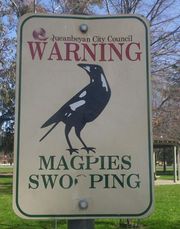
Warning sign about magpie swooping
To avoid swooping attacks, the best course is to avoid
the territory of nesting magpies during the relatively brief
nesting season. Magpies are a protected native species in
Australia, so it is illegal to kill or harm them.
If it is necessary to walk near the nest, some people
prefer to wear protection. Magpies prefer to swoop at the
back of the head; therefore, keeping the magpie in sight at
all times can discourage the bird. Using a basic disguise to
fool the magpie as to where a person is looking (such as
painting eyes on a hat, or wearing sunglasses on the back of
the head) can also prove effective, as can holding an object
above one's head. In some cases, magpies may become
extremely aggressive and attack people's faces; it may
become very difficult to deter these birds from swooping. If
a bird presents a serious nuisance the local authorities may
arrange for that bird to be legally euthanised, or more
commonly, to be caught and relocated to an unpopulated area.
Tameness
Australian Magpies are territorial, and this presents the
opportunity for people to get acquainted with the local
pairs and their offspring.
Popular culture
The magpie is a commonly used emblem of sporting teams in
Australia, most notably the
Collingwood Football Club, the Port Adelaide Magpies
Football Club, the Western Suburbs Rugby League Club and the
Souths-Logan Magpies Rugby League Club.
The white-backed magpie has been featured on the South
Australian flag since 1904 and coats of arms since 1984
under the name Piping Shrike.
References
External links




